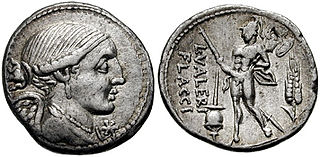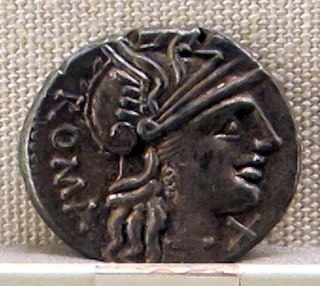Related Research Articles

The gens Claudia, sometimes written Clodia, was one of the most prominent patrician houses at Rome. The gens traced its origin to the earliest days of the Roman Republic. The first of the Claudii to obtain the consulship was Appius Claudius Sabinus Regillensis, in 495 BC, and from that time its members frequently held the highest offices of the state, both under the Republic and in imperial times.

The gens Valeria was a patrician family at ancient Rome, prominent from the very beginning of the Republic to the latest period of the Empire. Publius Valerius Poplicola was one of the consuls in 509 BC, the year that saw the overthrow of the Tarquins, and the members of his family were among the most celebrated statesmen and generals at the beginning of the Republic. Over the next ten centuries, few gentes produced as many distinguished men, and at every period the name of Valerius was constantly to be found in the lists of annual magistrates, and held in the highest honour. Several of the emperors claimed descent from the Valerii, whose name they bore as part of their official nomenclature.

The gens Furia, originally written Fusia, and sometimes found as Fouria on coins, was one of the most ancient and noble patrician houses at Rome. Its members held the highest offices of the state throughout the period of the Roman Republic. The first of the Furii to attain the consulship was Sextus Furius Medullinus in 488 BC.

The gens Fabia was one of the most ancient patrician families at Rome. The gens played a prominent part in history soon after the establishment of the Republic, and three brothers were invested with seven successive consulships, from 485 to 479 BC, thereby cementing the high repute of the family. Overall, the Fabii received 45 consulships during the Republic. The house derived its greatest lustre from the patriotic courage and tragic fate of the 306 Fabii in the Battle of the Cremera, 477 BC. But the Fabii were not distinguished as warriors alone; several members of the gens were also important in the history of Roman literature and the arts.

The gens Manlia was one of the oldest and noblest patrician houses at Rome, from the earliest days of the Republic until imperial times. The first of the gens to obtain the consulship was Gnaeus Manlius Cincinnatus, consul in 480 BC, and for nearly five centuries its members frequently held the most important magistracies. Many of them were distinguished statesmen and generals, and a number of prominent individuals under the Empire claimed the illustrious Manlii among their ancestors.

The gens Licinia was a celebrated plebeian family at Rome, which appears from the earliest days of the Republic until imperial times, and which eventually obtained the imperial dignity. The first of the gens to obtain the consulship was Gaius Licinius Calvus Stolo, who, as tribune of the plebs from 376 to 367 BC, prevented the election of any of the annual magistrates, until the patricians acquiesced to the passage of the lex Licinia Sextia, or Licinian Rogations. This law, named for Licinius and his colleague, Lucius Sextius, opened the consulship for the first time to the plebeians. Licinius himself was subsequently elected consul in 364 and 361 BC, and from this time, the Licinii became one of the most illustrious gentes in the Republic.

The gens Junia was one of the most celebrated families of ancient Rome. The gens may originally have been patrician, and was already prominent in the last days of the Roman monarchy. Lucius Junius Brutus was the nephew of Lucius Tarquinius Superbus, the seventh and last King of Rome, and on the expulsion of Tarquin in 509 BC, he became one of the first consuls of the Roman Republic.
The gens Papiria was an ancient patrician family at ancient Rome. According to tradition, the Papirii had already achieved prominence in the time of the kings, and the first Rex Sacrorum was a member of this gens. Lucius Papirius Mugillanus was the first of the Papirii to obtain the consulship in 444 BC. The patrician members of the family regularly occupied the highest offices of the Roman state down to the time of the Punic Wars. Most of the Papirii who held office under the later Republic belonged to various plebeian branches of the family. Although the most illustrious Papirii flourished in the time of the Republic, a number of the family continued to hold high office during the first two centuries of the Empire.
Appius Claudius Crassus Sabinus Regillensis, usually referred to simply as Appius Claudius Crassus or Crassinus, was a Roman politician during the fifth century BC. He was consul in 451 BC, alongside Titus Genucius Augurinus, and the same year chosen one of the decemvirs, a committee of ten men chosen in the place of consuls to draw up the tables of Roman law beginning in 451 BC. He was the only member of the college to serve a second term in 450, having appointed himself to the position, together with nine others whose opinions agreed with his or whom he was able to dominate. They continued in office the following year, without bothering to hold elections, but were overthrown in a popular revolt, and the consular government was restored.

The gens Marcia, occasionally written Martia, was one of the oldest and noblest houses at ancient Rome. They claimed descent from the second and fourth Roman Kings, and the first of the Marcii appearing in the history of the Republic would seem to have been patrician; but all of the families of the Marcii known in the later Republic were plebeian. The first to obtain the consulship was Gaius Marcius Rutilus in 357 BC, only a few years after the passage of the lex Licinia Sextia opened this office to the plebeians.

The gens Sempronia was a Roman family of great antiquity. It included both patrician and plebeian branches. The first of the Sempronii to obtain the consulship was Aulus Sempronius Atratinus, in 497 BC, the twelfth year of the Republic. The patrician Sempronii frequently obtained the highest offices of the state in the early centuries of the Republic, but they were eclipsed by the plebeian families of the gens at the end of the fourth century BC. The glory of the Sempronia gens is confined to the Republican period. Very few persons of this name, and none of them of any importance, are mentioned under the Empire.

The gens Minucia was a Roman family, which flourished from the earliest days of the Republic until imperial times. The gens was apparently of patrician origin, but was better known by its plebeian branches. The first of the Minucii to hold the consulship was Marcus Minucius Augurinus, elected consul in 497 BC.

The gens Antistia, sometimes written Antestia on coins, was a plebeian family at Rome. The first of the gens to achieve prominence was Sextus Antistius, tribune of the plebs in 422 BC.

The gens Pomponia was a plebeian family at Rome. Its members appear throughout the history of the Roman Republic, and into imperial times. The first of the gens to achieve prominence was Marcus Pomponius, tribune of the plebs in 449 BC; the first who obtained the consulship was Manius Pomponius Matho in 233 BC.

The gens Plaetoria was a plebeian family at Rome. A number of Plaetorii appear in history during the first and second centuries BC, but none of this gens ever obtained the consulship. Several Plaetorii issued denarii from the late 70s into the 40s, of which one of the best known alludes to the assassination of Caesar on the Ides of March, since one of the Plaetorii was a partisan of Pompeius during the Civil War.

The gens Sicinia was a plebeian family at ancient Rome. Members of this gens occur throughout the history of the Republic, but only one of them obtained the consulship, Titus Sicinius Sabinus in 487 BC. Throughout the long Conflict of the Orders, the Sicinii were celebrated for their efforts on behalf of the plebeians.
The gens Genucia was a prominent family of the Roman Republic. It was probably of patrician origin, but most of the Genucii appearing in history were plebeian. The first of the Genucii to hold the consulship was Titus Genucius Augurinus in 451 BC.
The gens Icilia was a plebeian family at Rome. During the early Republic, the Icilii were distinguished by their unwavering support for the rights of the plebeians against the patrician aristocracy.
The gens Villia was a plebeian family at Rome. Its members are mentioned in the first century of the Republic, but the only Villius who obtained the consulship was Publius Villius Tappulus, in BC 199.
The gens Oppia was an ancient Roman family, known from the first century of the Republic down to imperial times. The gens may originally have been patrician, as they supplied priestesses to the College of Vestals at a very early date, but all of the Oppii known to history were plebeians. None of them obtained the consulship until imperial times.
References
- ↑ Dictionary of Greek and Roman Biography and Mythology, vol. II, p. 709 ("Laetorius").
- ↑ The New College Latin & English Dictionary ("mergus").
- 1 2 Livy, ii. 27.
- ↑ Münzer, pp. 89 ff.
- ↑ Broughton, vol. I, p. 13.
- ↑ Broughton vol. i. pp. 13 Münzer, Römische Adelsparteien und Adelsfamilien, 1920, 89f.
- ↑ Livy, ii. 56–58.
- ↑ Dionysius, ix. 41–49.
- ↑ Broughton, vol. I, p. 30.
- ↑ Valerius Maximus vi. 1. § 11.
- ↑ Suda, s. v. Γάϊος Λαιτώριως.
- ↑ Dionysius, excerpta Valesiana, pp. 88 ff. (ed. Mai).
- ↑ Fasti Capitolini
- ↑ Broughton, vol. I, p. 288.
- ↑ Livy, xxiii. 30, xxv. 22, xxvi. 23, xxvii. 7, 8.
- ↑ Broughton, vol. I, pp. 270, 279, 284 (note 1), 288.
- ↑ Livy, xxx. 39.
- ↑ Broughton, vol. I, pp. 316, 318, 319.
- ↑ Dictionary of Greek and Roman Biography and Mythology, vol. II, p. 709 ("Laetorius", no. 7).
- ↑ Broughton, vol. I, pp. 325, 326 (note 5).
- ↑ Livy, xxxi. 21.
- ↑ Valerius Maximus, iv. 7. § 2.
- ↑ Plutarch, "The Life of Gaius Gracchus", 16, 17.
- ↑ Appian, Bellum Civile, i. 60 ff.